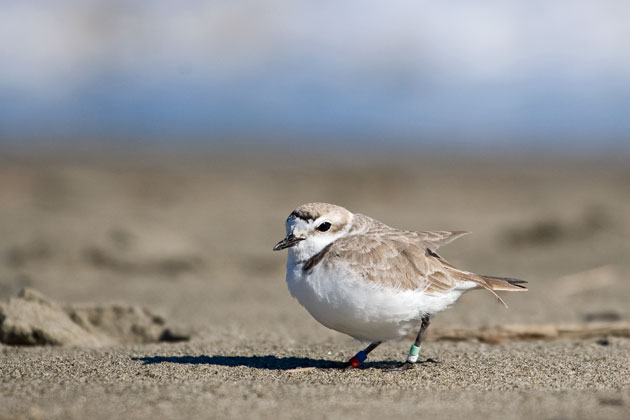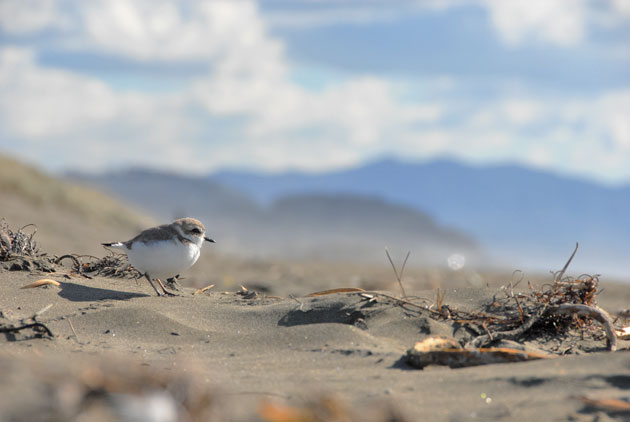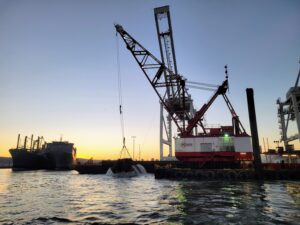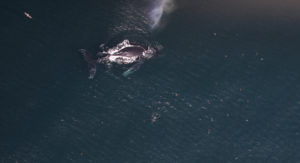Marching north along Ocean Beach on the San Francisco coast, Dan Murphy stops and points his binoculars at a clutch of birds that look like cotton balls with beaks.
“There they are,” says Murphy, a veteran bird watcher and volunteer with the Golden Gate Audubon Society. “It’s a scarce flock.”
Four western snowy plovers, small shorebirds listed as threatened under the Endangered Species Act, trot back and forth across the sand. They leave trails of three-pronged footprints in the wave-swept terrain on this cool September morning. Coastal dunes, like the ones at Ocean Beach, are the birds’ preferred habitat. A handful of the estimated 2,500 breeding adults left on the United States’ Pacific Coast spend the winter here each year.
“If beaches like this are cared for and controlled, the plovers will be okay,” Murphy says. “Otherwise, they’ll go extinct.”
But Ocean Beach, Murphy says, is in bad shape. Besides being overrun with foot traffic and free-roaming domestic pets, the beach has a serious erosion problem. Wind and waves have already reduced its southern portion to a narrow strip of sand and they are constantly chipping away at what’s left.
The erosion is a nightmare scenario for San Francisco, because it threatens major nearby infrastructure like the Great Highway and the Oceanside Water Pollution Control Plant. It has also spurred some environmentalists to take aim at industrial activities, specifically sand mining, which they say contribute to the problem. Their efforts, grounded in new science about sediment transport in the San Francisco Bay, could help determine whether western snowy plovers and shorebirds like them have a future at Ocean Beach.
Sediment transport in the Bay Area is a complex phenomenon, but, according to scientists at the U.S. Geological Survey, it works like this: Sand, gravel, and mud flow from the mountains and foothills into the San Joaquin-Sacramento Delta and other tributaries into San Francisco Bay, where some of the material remains while the rest flows out toward the ocean. There, currents may carry the smaller sand particles out the Golden Gate and down toward Ocean Beach and beyond.
For centuries, this continuous supply of sediment helps replenish coastal beaches south of the Golden Gate. Today, however, much of the sediment is trapped behind dams, diverted by flood control structures, removed by dredging, or sucked up by private sand mining corporations before it can reach the open water.
“The outer coast, from San Francisco to Pacifica and beyond, has some of the most rapidly eroding beaches in the state,” says Patrick Barnard, a USGS geologist who led a series of major studies on sediment transport in the Bay Area. “We have really not had sea level rise on the West Coast in 30 years, so the obvious [explanation for the erosion] is sediment supply.” Barnard says research indicates that human activity has reduced the sediment load leaving the Bay, and that sand mining is “certainly a contributing factor” to this phenomenon.
Sand mining, which uses hydraulic suction to slurp up sediment from underwater mineral deposits, has been ongoing in the Bay Area for more than 70 years. Mining companies use the extracted sand to manufacture a variety of products, including asphalt and concrete.
In October 2012, the California State Lands Commission (SLC) granted Hanson Marine Operations and Jerico Products new 10-year leases to mine state-owned underwater parcels near Angel Island and in Suisun Bay, and approved the companies’ plans to extract more than 2 million cubic yards of sediment each year.
Before granting the leases, the agency conducted a lengthy environmental impact review and concluded that sand mining’s influence on coastal erosion is insignificant. Sand mining, the agency wrote in the document, “is not likely to cause measurable sediment depletion outside the mining areas, such as the San Francisco Bar, Ocean Beach or other areas.”
San Francisco Baykeeper filed suit against the commission a month later, arguing, among other things, that the state’s final environmental impact review failed to use the best available science and inadequately accounted for coastal erosion. A state judge ruled against Baykeeper in April, and in July the organization appealed the case to the state’s First District Court of Appeals.
“They basically ignored the coastal impacts of sand mining, and that includes impacts to species on the coast,” says Sejal Choksi-Chugh, Baykeeper’s project director. In its lawsuit, Baykeeper relied heavily on the research of Patrick Barnard and his colleagues at the USGS, who have published several papers in the journal Marine Geology that detail how sediment circulates through the Bay.
“The sand we find throughout the Bay is both geochemically and mineralogically consistent with what is found on the outer beaches,” Barnard says. “The primary source of sand is coming down from the San Joaquin-Sacramento Delta and almost all the mining sites lie along that path.”
Nevertheless, the complexity of sediment transport in the Bay makes it difficult to determine exactly how much impact sand mining is having on coastal ecosystems.
“Yes, sure, there must be some impact out there on the coast from taking sand out of the Bay, but how much no one is willing to say yet,” says Tom Gandesbery, a project manager for the State Coastal Conservancy. “I don’t know if we will ever get to the point where we can say if you take 1,000 cubic yards out of the Bay that will mean 100 cubic yards out of Ocean Beach, but that is where the research is headed. That’s the hope.”
The California State Lands Commission would not comment in detail for this story, citing the ongoing legal proceedings.“We stand behind the great work that was done in the review,” says Sheri Pemberton, chief of external affairs at the California State Lands Commission.
The outcome of the case could determine whether Hanson and Jerico, which are still awaiting project approval from the San Francisco Bay Conservation and Development Commission, will be able to proceed with their proposed mining plans. It could also set a precedent for how sediment is managed in the Bay, with consequences for coastal beaches and the birds that inhabit them.

Back at Ocean Beach, Dan Murphy counts 32 western snowy plovers nestling in the sand, their brownish wings blending perfectly with the dark sediment. The birds prefer wide beaches so they can see predators approaching, and for good reason. Two loose dogs suddenly bolt towards the flock, barking and biting at the air, while their owner strolls near the surf. The plovers scatter.
“That settles it,” Murphy says, as he puts his binoculars and notebook away. “We’re done here.”
Jimmy Tobias is a reporter at the UC Berkeley Graduate School of Journalism and a former trail worker with the U.S. Forest Service. This story was produced as part of a J-school class focusing of environmental issues in the Bay Area.
For more information about western snowy plovers in San Francisco, see the Golden Gate Audubon Society’s snowy plover page.





